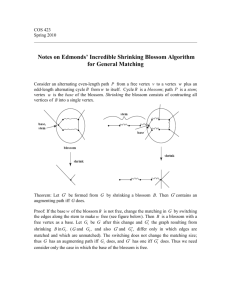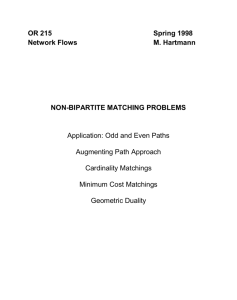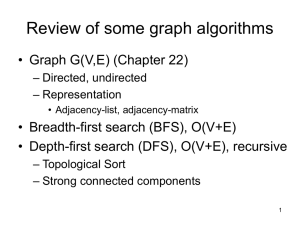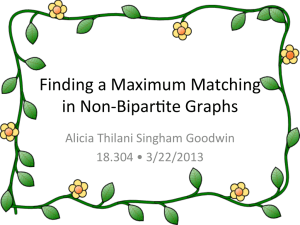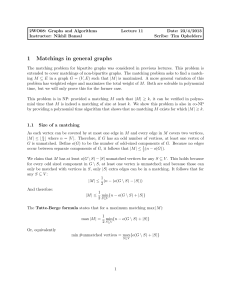Paths, Trees and Flowers
advertisement
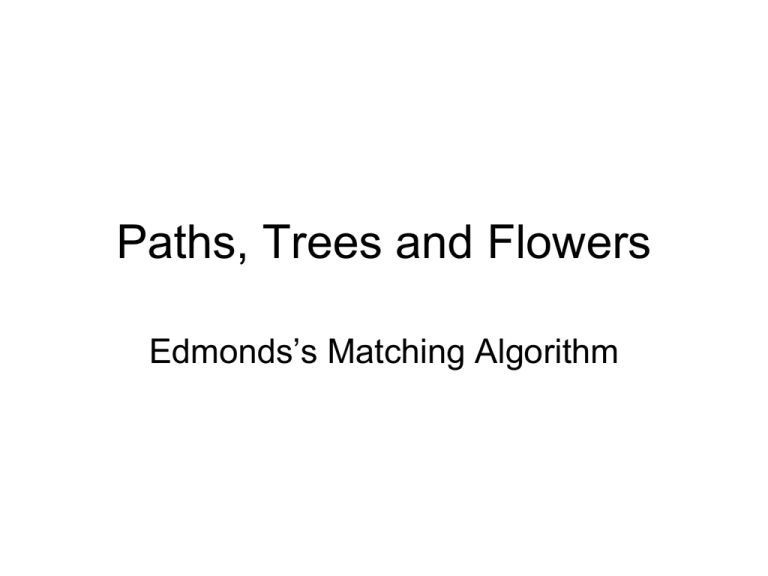
Paths, Trees and Flowers Edmonds’s Matching Algorithm Goals of the Paper • Establish appropriate criteria for judging the efficiency of an algorithm. – Edmonds proposes that the runtime of an ‘efficient’ algorithm should vary as a polynomial function with respect to the size of the input. • Show that an efficient algorithm exists for finding the maximum matching of any graph. – Edmonds showed his algorithm had an upper bound of n4 on its runtime where n is the number of vertices in the graph. Berge’s Theorem • A matching M of G is not of maximum cardinality iff (G, M) contains an alternating path joining two exposed vertices of M. Matching algorithm for Bipartite Graph • For each exposed vertex, grow a tree from the exposed vertex until another exposed vertex is reached or until the graph can be grown no further •To speed up the algorithm, we use existing trees when growing a tree from a new vertex. This way, each vertex is checked only once giving us a polynomial-time algorithm. Matching Algorithm for Non-Bipartite Graphs • If we try applying the previous algorithm to non-bipartite graphs it fails. Example: • If we include the edge (4,5) then we get a cycle in the tree. If we don’t include it then we fail to find the augmenting path: Blossoms • The cycle encountered in the previous example is called a blossom. More precisely a blossom is defined as a cycle of length 2k+1 where exactly k edges in the cycle are matching edges. Theorem: Let G’ be formed by contracting the edges of a blossom of G. Then G’ has an augmenting path iff G has an augmenting path. Edmonds’s Matching Algorithm Here is the general idea (a number of intricacies are excluded): • A graph G and a matching M of G is given. • Begin by growing trees from each exposed vertex. • Continue until an exposed vertex or a blossom is found or until tree can be grown no further. • If a blossom is found, contract the edges of the blossom in G and start over with new graph. • If an exposed vertex is found then we have found an augmenting path. Reverse contraction of blossoms and augment along augmenting path to obtain new matching M’. • Repeat with matching M’. Example Begin growing tree until blossom or exposed vertex is found. Contract blossom in in original graph and start growing tree again. Contract blossom in in original graph and start growing tree again. Augmenting path found. Reverse contractions of blossoms to obtain augmenting path in G. Time Complexity of the Algorithm General Idea: • Per blossom contraction, each edge is checked at most once. • The number of blossoms is less than the number of vertices. • Edmonds bounds the efficiency of his algorithm as n4. References Edmonds, Jack (1965). "Paths, trees, and flowers". Canad. J. Math. 17: 449–467. doi:10.4153/CJM-1965-045-4 Karp, Richard, "Edmonds's Non-Bipartite Matching Algorithm", Course Notes. U. C. Berkeley Edmonds's matching algorithm. (2011, August 30). In Wikipedia, The Free Encyclopedia. Retrieved 12:26, December 7, 2011, from http://en.wikipedia.org/w/index.php?title=Edmonds%27s _matching_algorithm&oldid=447433782
